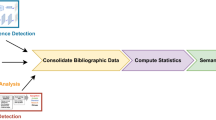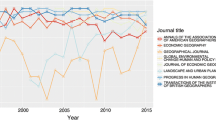Abstract
The influence of authors is mostly based on their capacity to form specific self-contained and/or active research communities or topics while also inspiring fruitful spin-off research derived from those communities or topics. Accurately estimating author influence and its indirect effect in inspiring external research creativity must thus be based on very precise community roles as well as topic-role analysis on citing material. In this paper we thus implement, compare, and combine two different kinds of knowledge mapping approaches used to track authors’ influence over time—a recent topic-based mapping approach and an original hybrid community-based mapping approach. The experimental context of our study is the analysis of the dynamics and of the influence of the research of Prof. Liu Zeyuan, the most important contributor in the field of Science of Science in China. This analysis focuses on papers citing Professor Liu Zeyuan's research and highlights the full extent of his creative thinking.











Similar content being viewed by others
Notes
We only considered papers for which an English title is provided.
Full disambiguation of Chinese names is a complex problem that is not solved here. Hence, different Chinese names might well have the same English spelling even though they refer to different persons.
In this article, the features represent the keywords extracted from the title and the abstract of the papers, the weights of the features are the adjusted frequency information associated with them and the unsupervised classification (clustering) is based on the GNG algorithm (Fritzke, 1995).
A feature with negative values can be separated into 2 different positive sub-features without loss of information. The first represents the positive part of the original feature and the second its negative part.
In Eq. 7, labels represent categories or clusters to which data are associated.
The GNG clustering is a crisp clustering process. Consequently, each original data (here the citing paper) is assigned to one single cluster.
The main visualization process is operated with Dash web application library, the overall management of network construction is dealt with Networkx library and the specific operations on communities are tackled with Community library.
In all our experiments the chosen threshold is 3.
The initial grouping of clusters into meta-topics was obtained using an expert analysis based on the evaluation of the similarity between clusters’ content (i.e., similarity between clusters’ most contrasted terms) as well as on external categorization of science of science into main domains as the one presented in (Lamirel et al. 2000). However, the groups obtained could also have been extracted by simply looking at the results of graph visualization approaches presented in section ″Contrast graph of the research topics of papers citing Liu’s research″ and ″Hybrid community-topic 3D-graph of the research topics of papers citing Liu’s research″ but these methods certainly prove to provide an inherent equivalent structuring.
From 2009, 5 training seminars on knowledge mapping were hold at WISELAB (Dalian University of Technology) to help widely disseminate the methods and thinking throughout China.
The “query on author” functionality is more precisely described in the presentation of the GraphL-3D algorithm in Sect. ″Community detection and community-topic 3D-graphs approach″.
References
Attik, M., Lamirel, J.-C., & Al Shehabi, S. (2006). Clustering analysis for data with multiple labels, Proceedings of IASTED International Conference on Databases and Applications (DBA), Innsbruck, Austria, February 2006.
Bernal, J. (1939). The social function of science. George Routledge & Sons Ltd.
Blei, D. M., Ng, A. Y., & Jordan, M. I. (2003). Latent Dirichlet allocation. Journal of machine Learning research, 3(Jan), 993–1022.
Blondel, V. D., Guillaume, J.-L., Lambiotte, R., & Lefebvre, E. (9 October 2008). "Fast unfolding of communities in large networks". Journal of Statistical Mechanics: Theory and Experiment. 2008 (10).
Chen, Y., & Liu, Z. (2005). The rise of mapping knowledge domain. Studies in Science of Science, 23(2), 149–154 (In Chinese).
Cuxac, P., & Lamirel, J.-C. (2013). Analysis of evolutions and interactions between science fields: the cooperation between feature selection and graph representation. In 14th COLLNET Meeting.
Cuxac, P., Lamirel, J.-C., & Kieffer, N. (2019). SKEEFT: indexing method taking into account the structure of the document. In 21th COLLNET meeting.
Fritzke, B. (1995). A growing neural gas network learns topologies. In Advances in neural information processing systems (pp. 625–632).
He, Y., Chen, Y., Cui, Y., & Liu, Z. (2017). Research approaches and prospects in the subject science of science based on the analysis of Bernal Price. Studies in Science of Science, 35(8), 1121–1129
Jiang, M., & Zhou, P. (2014). Research on the patent innovation performance of university-industry collaboration based on complex network analysis. Journal of Business-to-Business Marketing, 21(2), 65–83
Lancichinetti A., & Fortunato, S. (2009), Community detection algorithms: a comparative analysis, Physical review E, Jg.80, Nr.5, 056117.
Kobourov, S. G. (2012). Spring embedders and force directed graph drawing algorithms. arXiv preprint. arXiv:1201.3011
Lamirel, J.-C., Mall, R., Cuxac, P., & Safi, G. (2011). Variations to incremental growing neural gas algorithm based on label maximization. The 2011 International Joint Conference on Neural Networks (IJCNN). (pp. 956–965). New York: IEEE.
Lamirel, J.-C., Cuxac, P., Chivukula, A. S., & Hajlaoui, K. (2015). Optimizing text classification through efficient feature selection based on quality metric. Journal of Intelligent Information Systems, 45(3), 379–396. https://doi.org/10.1007/s10844-014-0317-4
Lamirel, J.C., Dugué, N., & Cuxac, P. (2016). New efficient clustering quality indexes. In 2016 International Joint Conference on Neural Networks (IJCNN), pp. 3649–3657. IEEE.
Lamirel, J.-C., Chen, Y., Cuxac, P., Al Shehabi, S., Liu, Z., & Dugue, N. (2020). Science of Science research in mainland China: 40 years of evolution: A new method of analysis based on clustering with feature maximization and contrast graphs. Scientometrics. https://doi.org/10.1007/s11192-020-03503-8
Liu, Z. (2002). On institutional science based on scientometrics. in Wang Zhanjun, Jiang Guohua, et al. Research evaluation and university evaluation [M]. Beijing: Hongqi publication, 2002, p410. (In Chinese)
Liu, Z. (2006). Thinking about the construction of “Science of science” theory system—The report about the progress of “Science of science” which based on scientometrics in China and foreign countries [J]. Studies in Science of Science, 2006(01), 1–11 (In Chinese).
Liu, Z. (2009). Tsien Hsue-shen's outlook on the knowledge-based economy in the view of epistemology - study the letter from Tsien Hsue-shen about the "knowledge economy"[J]. Studies in Science of Science, 27(12):1772–1776. (In Chinese)
Liu, Z. (2017). Feng Zhijun’s Puzzle: What is the core theory of the science of science? Studies in Science of Science, 35(5), 655–660 (In Chinese).
Mihalcea, R., & Tarau, P. (2004). TextRank: Bringing Order into Texts. Proceedings of the 2004 Conference on Empirical Methods in Natural Language Processing, pp. 404–411.
Qian, W., & Li, X. (2012). J. D. Bernal and China. Science & Culture Review, 16–32. (In Chinese)
Rosvall, M., & Bergstrom, C. T. (2008), “Maps of random walks on complexe net- works reveal community structure”, Proceedings of the National Academy of Sciences USA, Jg.105, Nr.4, S.1118–1123.
Tsien, H. (1979). Science of science, studies in science and technology system. Marx’s Philosophy. Philosophical Research, 1, 20–27 (In Chinese).
Tsien, H. (1980). On the establishment and development of Marxist science of science for the foundation of research management. Research management, 1, 3–8
Van Raan, A. (2019). Measuring science: Basic principles and application of advanced bibliometrics. springer handbook of science and technology indicators. In: Glanzel, W., Moed, H. F., Schmoch, H., & Thelwall, M. (Eds.), Springer International Publishing, pp. 237–280.
Velden, T., Yan, S., & Lagoze, C. (2017). Mapping the cognitive structure of astrophysics by infomap clustering of the citation network and topic affinity analysis. Scientometrics, 111(2), 1033–1051
Yu, S.-Y. (2015). Combining ego-centric network analysis and dynamic citation network analysis to topic modeling for characterizing research trends. Journal of the Korean Society for information Management, 32(1), 153–169
Acknowledgements
We wish to thank Prof. Chen Yue who took on the role of main domain expert for this paper. We are also grateful to her for all her advice which helped us improve our critical view of our results. We also wish to warmly thank Richard Dickinson of the Inist in Nancy for the careful proofreading of our paper.
Author information
Authors and Affiliations
Corresponding author
Rights and permissions
About this article
Cite this article
Lamirel, JC., Gueddari, Y., Wang, Y. et al. Analysis of the dynamics and influence of the research work of Prof. Liu Zeyuan in China featuring a new hybrid approach combining community detection with topic tracking. Scientometrics 126, 6273–6300 (2021). https://doi.org/10.1007/s11192-021-04010-0
Received:
Accepted:
Published:
Issue Date:
DOI: https://doi.org/10.1007/s11192-021-04010-0




